In recent years, with the increasing importance of ecological problems, the excessive use of non-renewable energy has had a significant impact on the environment. For example, smog in China has been particularly serious in recent years, which highlights the importance of clean renewable energy. . In recent years, the photovoltaic industry, as a representative of the renewable energy industry, has been rapidly developed and applied in various fields of people's lives. The output characteristics of photovoltaic modules are related to factors such as light intensity and ambient temperature [1]. Typically, the manufacturer only provides external output characteristics and corresponding electrical nameplate parameters for PV modules under standard conditions. In practical applications, the PV modules are basically not operated under the standard conditions, so it is practical to obtain the external output characteristics and corresponding electrical parameters of the PV modules under different conditions, and also the operating conditions of the PV modules under different working conditions. Analysis provides the basis.
Since the output characteristics of photovoltaic modules vary significantly with the external environment, it is a problem to be solved by selecting a suitable PV module model and accurately identifying its internal 5 parameters [2]. A typical single diode model is chosen and the model is also highly accurate in engineering applications [3]. The methods for parameter identification are mainly divided into approximate mathematical analysis method and parameter identification method based on optimization algorithm. In [4-5], the approximate mathematical analysis algorithm is adopted. For the mathematical analysis algorithm of parameter approximation, due to the existence of complex transcendental nonlinear functions, and some parameters directly approximate the fixed values, the accuracy of the calculated parameters is greatly reduced. The literature [6] uses the CPSO algorithm, although the convergence accuracy is achieved, but the number of iterations is large. In short, the parameter identification method based on intelligent optimization algorithm has obvious advantages in accuracy and reliability, but most of the traditional optimization algorithms still have problems such as easy to fall into premature or iterative optimization times. Therefore, based on this, an improved quantum particle swarm optimization algorithm is proposed to identify the internal parameters of PV modules, which not only solves the problem that PSO algorithm falls into local optimum, but also solves the problem of too many iterations in the optimization process. In addition, the external output characteristics of the PV module and the internal five parameters show a complex nonlinear relationship with the external environment. Therefore, how to accurately predict the output characteristic curve and corresponding internal parameters under different working conditions is of great significance.
1 Photovoltaic battery theoretical model and objective function
1.1 Photovoltaic battery theoretical model
Photovoltaic cells are devices that use solar photovoltaic effects to convert solar energy into electrical energy. The single-diode model is shown in Figure 1 [7].

Figure 1 shows the equivalent current and voltage expressions for the internal parameters of the PV module:

Where U is the voltage across the load, I is the current through the load, Iph is the photo-generated current, Io is the diode reverse saturation current, A is the diode influence factor, Rs is the battery series resistance, Rsh is the battery shunt resistance, T is The absolute temperature of the battery, K is the Boltzmann constant (1.38 × 10-23 J/K), and q is the charge constant (1.6 × 10-19 C). Iph, Io, A, Rs, and Rsh are parameters to be identified.
1.2 Establishment of the objective function
Based on the theoretical model characteristics of the above-mentioned photovoltaic modules, the improved quantum particle swarm algorithm is introduced to accurately extract the values ​​of the unknown 5 parameters in the model. Reference [8] cites the Lambert W function to simplify the explicit expression of the photovoltaic cell current I:
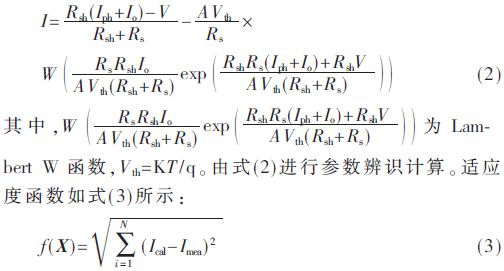
Where X = (Iph, Io, A, Rs, Rsh) is the position vector of each particle, representing the parameter values ​​of the five battery models. Ical and Imea respectively enter the identification current value and the actual current value obtained in equation (2) for the parameters identified by the algorithm. The smaller the fitness value, the more accurate the identification parameter is.
2 algorithm introduction
2.1 Quantum Particle Swarm
In 2004, Sun et al. proposed the Quantum Particle Swarm Optimization (QPSO) algorithm, which is a property of quantum particles from the perspective of quantum mechanics that satisfies the aggregation. The aggregation of particles is described by the bound state of the center of particle motion, which is the attraction that exists in the particle. Particles in a bound state can appear at any point in the quantum space with a certain probability density. The iterative process of particles is described in detail in [9].
2.2 Improved Quantum Particle Swarm Optimization
Since the population initialization in the QPSO algorithm is randomly distributed [10], the population initialization has certain limitations and cannot traverse the entire region. Therefore, the chaotic initialization of its population is proposed to improve the traversal range of particle initialization, and the local optimal solution is chaotically processed in the optimization process to prevent it from falling into the local optimal solution. Chaos is proposed by EN Lorenz. Since the chaotic state is different from the general irregular state, its main features are regularity, randomness and ergodicity, so chaos theory has become a new and potential optimization tool. Since chaotic sequences have the above advantages, the use of chaotic sequences for initializing particles can improve the ergodicity of particle initialization, thus laying the foundation for optimization accuracy and convergence speed. The Logistic chaotic equation [11] is shown in equation (4):

In the formula, 0 ≤ Z0 ≤ 1, Zi is the i-th variation, and μ is the control coefficient.
3 PV component output characteristic prediction experiment based on parameter identification
3.1 Simulation experiment verification example
According to the parameter characteristics of PV module 5, the PV module simulation model [11] is established in MATLAB/Simulink, and the corresponding parameter identification data is obtained. The electrical parameters of the PV module in the model are Im=4.95 A, Vm=35.2 V, Voc=44.2 V, Isc=5.2 A; in order to verify the accuracy and rapidity of the above parameter identification method, the simulation model is in the standard condition. The next set of data is identified by PSO, QPSO, CQPSO and CPSO methods and compared. The test is iterated 100 times. The value of the fitness function can directly reflect the accuracy of parameter identification. Figure 2 shows the difference. The fitness value change graph after the method is iterated. Table 1 shows the PV module parameter values ​​identified by different algorithms. Combining the relevant data and image display in Table 1 and Figure 2, it can be concluded that the CQPSO algorithm has a fitness value of 0.037 014, which is much higher than the 0.542 4 of the PSO, and the iteration times only need 18 times to converge. It is much faster than the QPSO iteration 33 times and the CPSO iteration 68 times in the literature [8], so the improved quantum particle group avoids falling into local optimum, improves the convergence precision, and accelerates the convergence speed. The internal parameters of the PV module can be accurately identified, and the problems that other algorithms are easy to fall into local optimum and the number of iterations are optimized.
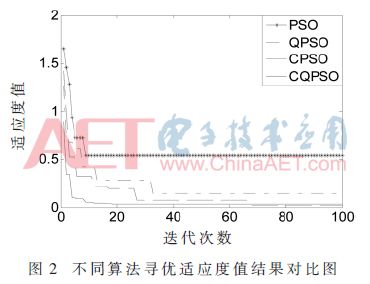
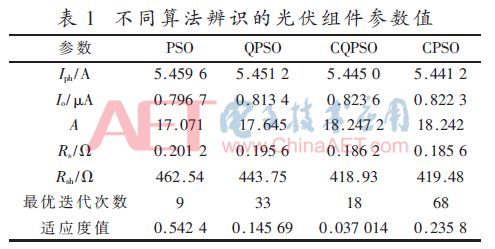
On this basis, in order to further explain the accuracy of parameter identification for output characteristic prediction, this paper uses 50 data points given under three different conditions of temperature and light intensity under the condition of simulation model, respectively. It is brought into the improved quantum particle swarm algorithm to perform model parameter identification, and the obtained parameter results are shown in Table 2. At the same time, the output characteristic IU curve corresponding to different working conditions is fitted by the algorithm identification result, as shown in Fig. 3.
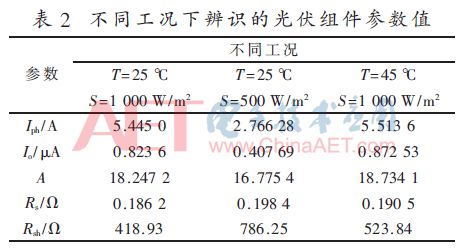

It can be seen from the comparison in Fig. 3 that the identified parameter value has a small error with the given value, and the PV module power curve and the set value curve overlap are recognized, indicating that the algorithm can identify the parameters under different working conditions. Have higher accuracy. In order to verify the accuracy of the output characteristics prediction, this paper introduces the predicted current percentage error function PE, as shown in equation (5), to compare the accuracy of the representative maximum power point current Imp in the output characteristics, as shown in Table 3. The absolute error rate of the table is less than 0.5%, which indicates that this method is very effective and applicable to the prediction of the output characteristics of the simulation model.
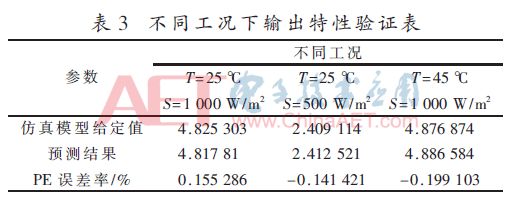

3.2 Experimental data verification example
In order to verify the prediction effect of this prediction model under the actual environment, the algorithm uses the algorithm for parameter identification and output characteristic prediction accuracy under the conditions of irradiance of 260 W/m2 and photovoltaic panel temperature of 37 °C (310K). verification. Under this condition, 45 data values ​​are selected for identification. The internal mathematical parameter values ​​are respectively identified by the traditional mathematical analysis algorithm and the improved two algorithms, as shown in Table 4. The identification parameters corresponding to the different algorithms in Table 4 are substituted into the original equation of equation (2) to fit the measured data output characteristic curves corresponding to the three algorithms, as shown in Fig. 4. The three current values ​​fitted in Figure 4 are brought into the current percentage error function of equation (5) to obtain the predicted current error percentage for the three algorithms in Figure 5.

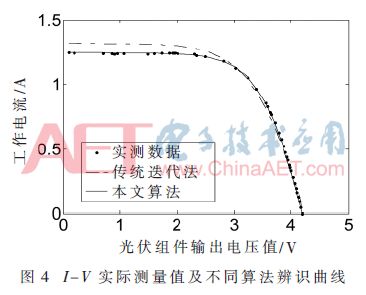
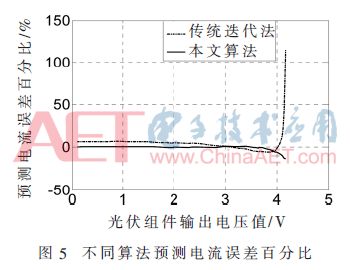
From the fitness value in Table 4, the improved algorithm can still obtain high-precision identification parameter values ​​under the measured data conditions, which proves the accuracy and applicability of the algorithm in parameter identification. From the output characteristic curve fitted by the two methods in Fig. 4, it can be seen that the difference between the identification curves of different algorithms is very large, and the algorithm makes the actual measured value and the fitting curve basically coincide. The higher degree of fitting indicates the accuracy of current prediction. Sex. The predicted current error percentage in Figure 5 can be seen as the current error rate of the algorithm is almost 0, which also shows that this method has higher accuracy for the output characteristic prediction, which fully verifies the accuracy of the PV component output characteristics prediction under the measured conditions.
In summary, in the example, different algorithms are used to identify the internal parameters of the PV modules under the simulation model, and the accuracy and rapidity of the proposed algorithm are compared. Through this algorithm, the output characteristics of PV modules under different working conditions are accurately predicted. Then the algorithm and traditional iterative algorithm are used to identify the PV module data and predict the output characteristics. The experimental results show that the parameters of the algorithm are The accuracy of the identification and the correctness and validity of the output characteristics prediction.
4 Conclusion
In this paper, the internal parameters of the PV module are accurately identified by the improved algorithm. The PV module simulation model and the measured data in the actual environment are subjected to parameter identification and output characteristics prediction experiments. In the simulation experiment, the parameters of the PV module 5 under the standard conditions are identified by three particle swarm optimization algorithms. It is concluded that the improved quantum particle swarm algorithm has fast convergence speed and high precision, and avoids falling into local optimum. The validity and accuracy of the parameters are identified. Then, the improved quantum particle swarm algorithm is used to identify the PV modules under different temperatures and light intensities. The corresponding output characteristic curves are fitted through the identification results, and the current error percentage is calculated. The accuracy of this method for predicting the output characteristics of the simulation model is verified and demonstrated. In order to further verify the accuracy of the parameter identification and the limited prediction of the output characteristics, this paper uses the measured data under the general working conditions (S=260 W/m2, T=37 °C). The accuracy is verified, and the verification results show that the method has general engineering applicability and high accuracy. This paper has wide applicability to PV module parameter identification and output characteristic prediction. It can provide support for the research of maximum power point tracking (MPPT) and fault diagnosis in PV modules, and has high engineering use value and promotion significance.
Ningbo Autrends International Trade Co.,Ltd. , https://www.mosvapor.com